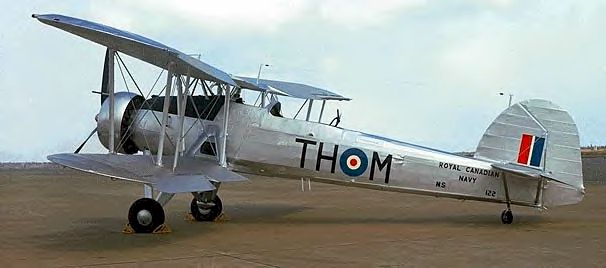|

Fairey Swordfish II of the Canada
Aviation Museum in Ottawa.
(Photographer unknown. Please contact us if you
deserve credit.)
History: When British naval intelligence
determined that a large number of Italian warships lay at anchor in Taranto harbor in
November 1940, an attack was organized, to be carried out by 21 single-engine
carrier-based biplanes. The operation was a huge success -- three battleships were
severely damaged, a cruiser and two destroyers were hit, and two other vessels were sunk.
In the space of one hour the balance of naval power in the Mediterranean had been altered
forever.
The unlikely cause of this destruction was one of the
warplane legends of World War Two, the Fairey Swordfish Mk.1,
first flown on 17 April 1934. It was a three-man torpedo-bomber and reconnaissance biplane
with a basic structure of fabric-covered metal. The wings folded for storage on the
crowded deck of an aircraft carrier. Armament included one forward-firing Vickers machine
gun and one swiveling Vickers in the rear cockpit. Primary offensive power took the form
of depth charges, mines, bombs or, especially, a torpedo.
Unfortunately, this outstanding plane was too slow to
withstand the punishment of German anti-aircraft fire. Long, accurate approaches to the
target made the Swordfish very vulnerable when delivering its torpedo. Thus came
re-deployment in an anti-submarine warfare role, using depth charges and, later, rockets.
As with many wartime aircraft, Swordfish were produced by
more than one manufacturer. Well over half (almost 1700) were built by the Blackburn
company in Sherburn in Elmet, UK.
The Mk II model was introduced in
1943, and featured strengthened and metal-skinned lower wings to allow the firing of
rockets from underneath. Later that year, the Mk III appeared,
which featured a large ASV anti-submarine radar unit mounted between the landing gear legs
which allowed detection of submarines up to 40 km away. For operation over the cold waters
of Canada, the Swordfish Mk IV was fitted with an enclosed
cabin.
When production ended in 1944, the Swordfish had had been
introduced into a full range of duties for the fleet: Torpedo-bomber, minelayer, convoy
escort, anti-submarine warfare (ASW) aircraft and training craft. Today, two Swordfish
are airworthy -- one in Britain and one in Canada.
Nicknames: Stringbag; Blackfish
(Blackburn-built Swordfish)
Specifications (Swordfish Mk II):
Engine: One 750-hp Bristol Pegasus XXX 9-cylinder radial piston engine
Weight: Empty 4,700 lbs., Max
Takeoff 7,510 lbs.
Wing Span: 45ft. 6in.
Length: 35ft. 8in.
Height: 12ft. 4in.
Performance:
Maximum Speed:
138 mph
Ceiling: 10,700
ft.
Range: 1,030
miles
Armament: Two 7.7-mm (0.303-inch)
Vickers machine guns (one forward-firing and one one in a Fairey High-Speed Mounting in
rear cockpit); plus one 1,600-pound torpedo, or 1,500 pounds of depth charges, bombs or
mines; or up to eight rockets on underwing racks.
Number Built: 2,391
Number Still Airworthy:
Two
Links:
Aircraft
Research Center -- Swordfish Walkaround
Canada Aviation Museum Swordfish page
Fighting the
U-Boats: The Fairey Swordfish
Fly Navy Heritage --
Swordfish Page
Greg Goebel's Fairey Swordfish
History
Swordfish Heritage Trust, Yeovilton,
UK

[Back to Warbird Alley's Main
Page]
All text and photos Copyright 2016, The
Doublestar Group, unless otherwise noted.
You may use this page for your own, non-commercial reference purposes only.
 |